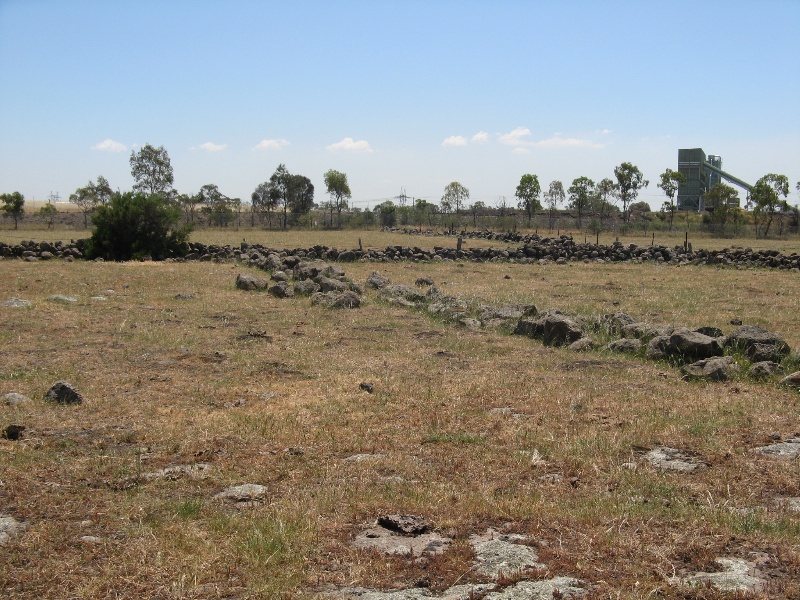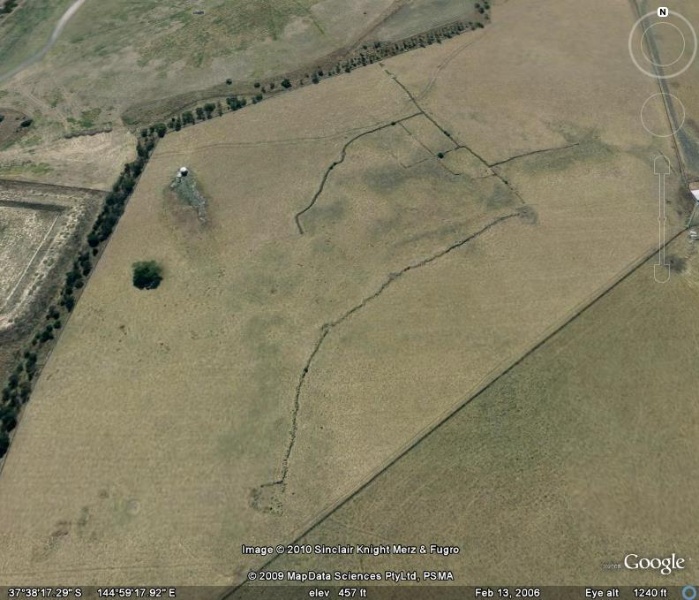CLONARD - SHEEP YARDS REMNANT DRY STONE WALLS
275 OHERNS ROAD EPPING, WHITTLESEA CITY
-
Add to tour
You must log in to do that.
-
Share
-
Shortlist place
You must log in to do that.
- Download report







Statement of Significance
The remnants of the dry stone sheep yard walls at Clonard were built at an unknown date on the old 480 acre (194 ha) Maryfield farm. This was purchased in 1840 by John Alston, and probably used for grazing, with the less stony parts cropped for wheat or hay, until Alston lost the farm in the 1840s depression. It was leased from 1858 to Friedrich Winter, who probably built the dry stone walls around the boundary at that time, and is likely to have used the farm largely for dairying. It is not known whether the sheepyard walls were built by Winter, or whether they were begun by Alston.
The remnants of the dry stone sheep yard walls at Clonard form an irregular complex of walls on the western part of Clonard, to the west of the Hume Freeway. The walls are in poor condition. Some enclose small paddocks, some of which would once have been used for stock and some for small cultivation paddocks. Some walls are distinctive in appearing to follow the natural divide between the stony land and patches of clear soil, and probably separated stock from the crops grown within. This latter kind of wall seems to be particularly associated with the Wollert area, and a few other examples have been identified. Some walls do not appear to form enclosures, and may have been part of yarding strategies, or may be walls remaining from once-larger paddocks.
The remnant sheepyard dry stone walls at Clonard are of archaeological significance for their potential to contain information about the construction and use of the site.
-
-
CLONARD - SHEEP YARDS REMNANT DRY STONE WALLS - History
CONTEXTUAL HISTORY
Dry Stone walling in Victoria
Dry stone walls are known from almost all the country of Europe and Asia, the most common use being for building farm walls: to create boundaries, separate sheep from cattle and stock from crops and protect houses and gardens. The tradition was brought to Victoria mainly by immigrants from Britain and Germany. Some walls were known of in the 1840s, for example in the Portland Bay District, but most examples in Victoria date from the second half of the nineteenth century, especially after the gold rushes, when labour to build walls became cheap.
Extensive areas of dry stone walls are found only in the volcanic regions of Australia. In Victoria they occur primarily on the volcanic plains which extend form north of Melbourne to the South Australia border. Large parts of the plains are covered in loose surface stone, ranging in size from pebbles to large boulders, which could be used to build fences and other structures.
Walls are most likely to be found in areas where early settlement coincided with large quantities of suitable stone. Walls were constructed to provide small holding paddocks for stock and define their boundaries. From the mid-1860s stone walls became more common after land sales and the later Selection Acts encouraged private ownership and required improvements to the land, such as fencing. A common variant of stone walls in Victoria was timber and wire fencing with low stone walls at the base.
Labour was cheap in the 1860s and dry stone walls, which could use the abundant free stone gathered from the fields, was no more expensive than post and rail fencing. Most of the walls in the region were built between the 1850s, when most of the land was opened for sale and the 1880s when cheap and effective fencing substitutes such as barbed wire became more economical. There was also then a change from grazing sheep to more intensive cattle rearing and dairy farming.
The areas best known for their stone walls, which are almost universally of basalt, are the Western District, the Koroit/Port Fairy area and the Yandoit-Daylesford area (Swiss-Italian). North of Melbourne in a small area around what used to be called Westgarthtown (the Thomastown/Epping/Wollert district) a group of German immigrants established a farming community, which replicated the building forms of their homeland. Stone walls in this area are common round small fields and farm yards and their construction mirrors that of the early bluestone buildings constructed by the German settlers.
(Gary Vines, Built to Last. An historical and archaeological survey of Dry Stone Walls in Melbourne's Western Region, 1990.)
According to Gary Vines, 'Comparative Analysis of Dry Stone Walls in Victoria, Australia and Overseas', in If these walls could talk, Terang 1999 [1995], pp 58-9)
the dry stone walls on the basalt plains to the north and west of Melbourne form a reasonably distinct regional style. . The regional style is characterised by walls constructed using the local rounded, smoothly-weathered, basalt field-stone of variable size. They are generally fairly low walls, averaging 1.2 metres . Coursing is uncommon although coping is almost always found on intact walls and throughstones can usually be identified at regular intervals of about one metre. . Because of their rounded shape the stones are rarely suited to the close-fitting construction seen on Western District walls, either for the main part of the wall or the coping.
Because many areas have only enough stone to form a low wall at the boundary of the 100 - 640 acre allotments, post and two or three wire fencing is common above the two to three foot (600 to 900 millimetre) high walls. Variations on the post and wire supplementary fence are post and single rail fence built into the wall .
Around Thomastown, the former German village of Westgarthtown has a few remnants of dry stone walls erected by the tightly knit group of German immigrants who established a mixed farming and dairy community . Their plots of land . featured dry stone walls as property boundaries and for fencing cultivation paddocks and animal yards. The characteristic of these wide walls is the rather crude construction technique, which lacks both coursing or coping stones, often with vertical sides and little evidence of throughstones. The lack of copes and throughs is probably a result of the rather small stone in the district, but the other characteristics probably reflect on the farmers' own construction skills as opposed to the professional wall builders who worked elsewhere.
HISTORY OF PLACE
[Information largely from David Moloney, 'Heritage Assessment of Clonard. 275 O'Herns Road, Epping', October 2009]
In the western part of Clonard are a number of dry stone walls which are irregular in form, compared to the straight boundary walls, and in poor condition.
Such walls are associated with early farming practices. Some form asymmetrically shaped enclosures and were probably built as stock pens. Some were probably built to keep stock away from a small area of arable land, which was used for cropping as it was relatively free of stones compared to the rest of the property.
Some of the irregular walls are distinctive in apparently following the natural divide between stony land (used for pasture) and relatively clear patches (used for cropping). The nominator notes that this area was used by James Bunting, the owner in the first half of the twentieth century, to grow corn as cattle feed. Such walls appear to be particularly associated with the Wollert area: none have been found elsewhere.
Other walls do not form enclosures and may have been used as part of a yarding strategy or be walls remaining from once-larger paddocks.
Moloney considers that these walls probably date from the Winter period, but suggests that they could even be from the Alston period of ownership, given that Alston would have cropped in this area, and needed fences or walls to keep stock away, but there is no evidence for this.
CLONARD - SHEEP YARDS REMNANT DRY STONE WALLS - Assessment Against Criteria
a. Importance to the course, or pattern, of Victoria's cultural history
b. Possession of uncommon, rare or endangered aspects of Victoria's cultural history.
c. Potential to yield information that will contribute to an understanding of Victoria's cultural history.
The remnant sheepyard dry stone walls at Clonard are of archaeological significance for their potential to contain information about the construction and use of the site.
d. Importance in demonstrating the principal characteristics of a class of cultural places or environments.
e. Importance in exhibiting particular aesthetic characteristics.
f. Importance in demonstrating a high degree of creative or technical achievement at a particular period.
g. Strong or special association with a particular community or cultural group for social, cultural or spiritual reasons. This includes the significance of a place to Indigenous peoples as part of their continuing and developing cultural traditions.
h. Special association with the life or works of a person, or group of persons, of importance in Victoria's history.
Heritage Inventory Description
CLONARD - SHEEP YARDS REMNANT DRY STONE WALLS - Heritage Inventory Description
Deteriorated basalt drystone wall network of enclosures.
-
-
-
-
-
HORSE DRAWN STONE-CARRYING SLED
 Victorian Heritage Register H2237
Victorian Heritage Register H2237 -
DRY STONE WALL
 Victorian Heritage Inventory
Victorian Heritage Inventory -
CLONARD HOMESTEAD
 Victorian Heritage Inventory
Victorian Heritage Inventory
-
-








